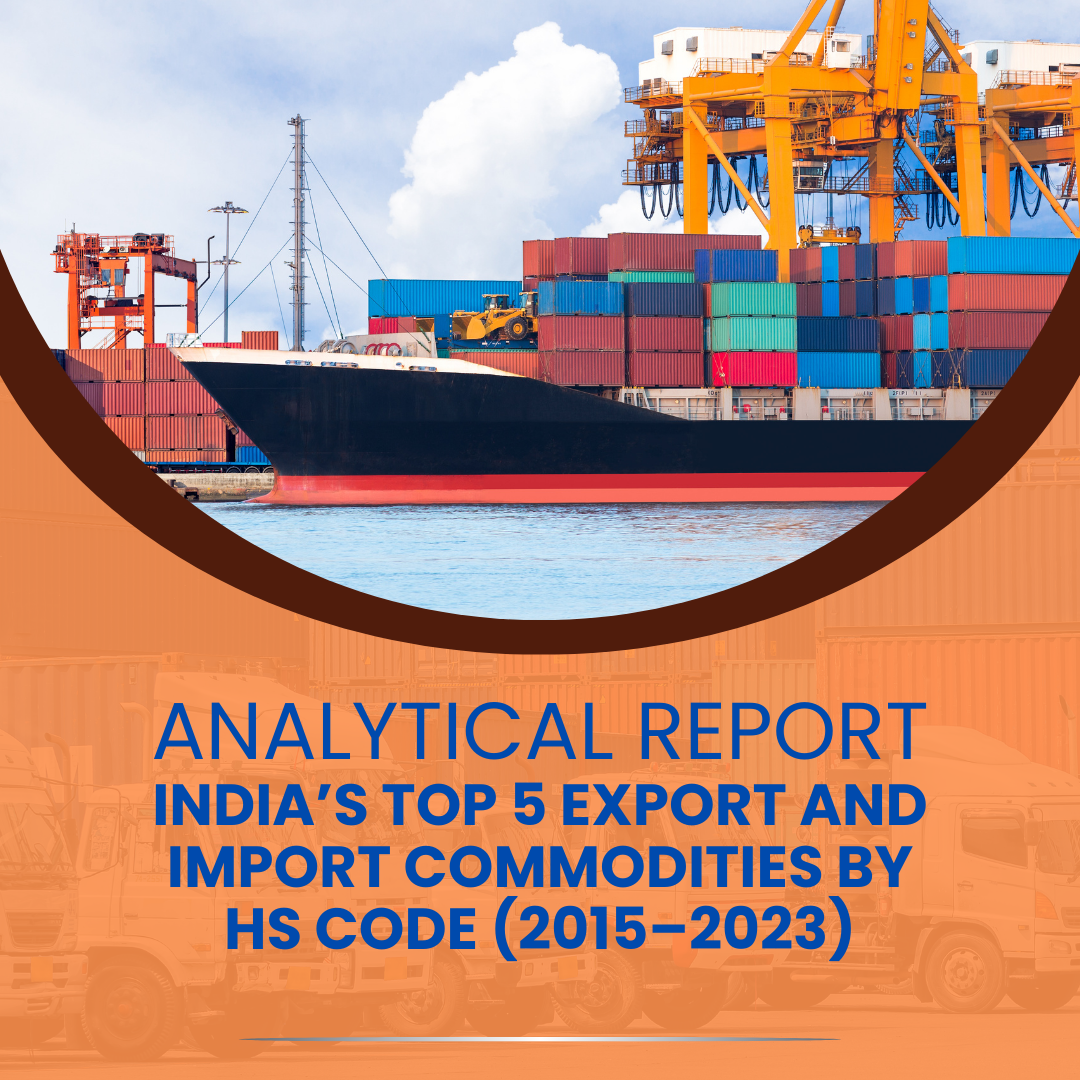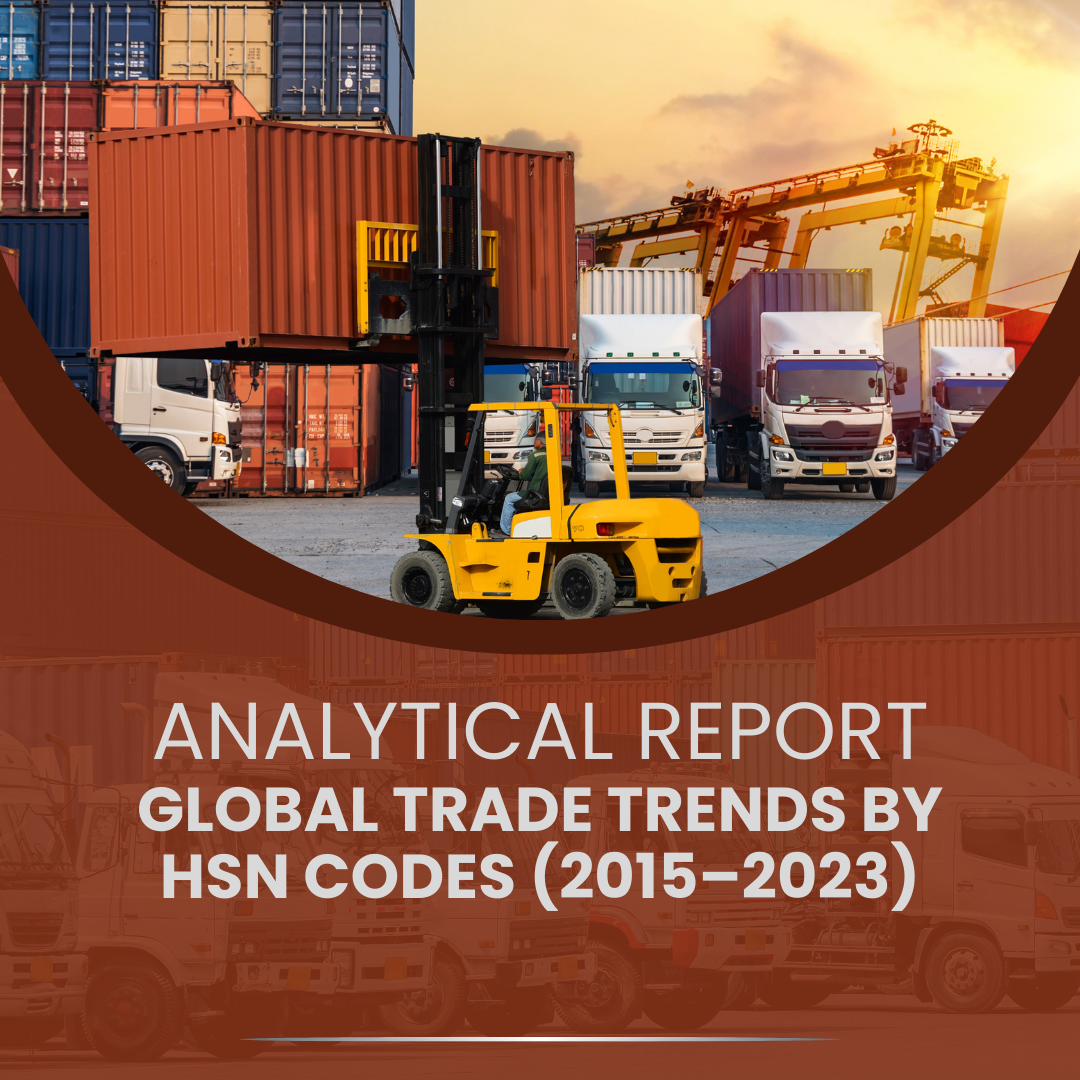
India’s merchandise trade has been pivotal to its economic growth, with exports and imports reflecting its evolving role in global markets. From 2015 to 2023, India’s trade dynamics shifted due to global economic challenges, policy reforms, and strategic diversification. This report analyzes India’s top 5 export and import commodities by HS code (6-digit level), focusing on their trade values, YoY growth, and contributions to India’s trade balance. Using data from WITS, DGCI&S, and recent sources, the analysis provides insights into India’s trade performance, key drivers, and policy implications.
Objectives:
- Identify and analyze India’s top 5 export and import commodities by HS code for 2015–2023.
- Quantify trade values, YoY growth, and trade shares.
- Assess contributions to India’s trade deficit and strategic trade trends.
- Offer recommendations for policymakers and industries.
Data and Methodology
1 Data Sources
- World Integrated Trade Solution (WITS): UN COMTRADE for trade flows, UNCTAD TRAINS for tariffs.
- Indian Ministry of Commerce (DGCI&S): Commodity-wise trade data at 8-digit HS code level, aggregated to 6-digit for analysis.
- Web Results: (Pazago, 2024) for 2023-24 commodity values and YoY trends.
- Other Sources: India Trade Portal, OEC, and India Exim Bank for trade statistics.
- Scope: India’s merchandise trade (exports from India, imports to India) for top 5 HS 6-digit commodities.
- Time Period: 2015–2023, with 2023 data estimated using 2023-24 fiscal year trends (April 2023–March 2024).
- Currency: US$ billion (converted from INR using average annual exchange rates, e.g., 1 USD = 82 INR for 2023).
2 India’s Top 5 Export and Import Commodities by HS Code
Based on 2023-24 trade values from and DGCI&S data, the top 5 export and import commodities (HS 6-digit) were selected, prioritizing India’s trade profile over global trends. The commodities reflect India’s strengths (e.g., petroleum, electronics) and import dependencies (e.g., crude oil, gold).Below is a table summarizing India’s Top 5 Export and Import Commodities by HS Code (6-digit level) as specified in the provided text. The table includes the HS code, commodity description, and product category for each of the top 5 export and import commodities.
| Category | HS Code | Commodity Description | Product Category |
| Exports | |||
| 1 | 271019 | Automotive Diesel Fuel | Refined petroleum products |
| 2 | 851713 | Smartphones | Mobile phones |
| 3 | 710239 | Diamonds, Non-Industrial | Cut diamonds |
| 4 | 300490 | Medicaments | Pharmaceutical drugs |
| 5 | 841112 | Turbo-Jets | Aerospace engines |
| Imports | |||
| 1 | 270900 | Petroleum Crude | Crude oil |
| 2 | 710812 | Unwrought Gold | Gold bullion |
| 3 | 271111 | Liquified Natural Gas (LNG) | LNG |
| 4 | 854231 | Monolithic Integrated Circuits, Digital | Semiconductors |
| 5 | 847130 | Personal Computers | Laptops and desktops |
3 Methodology
- Data Extraction:
- Export/import values by HS 6-digit codes from WITS and DGCI&S, aggregated from 8-digit data.
- 2023 values estimated using 2023-24 fiscal year data and Ministry of Commerce reports.
- Descriptive Statistics:
- Calculated mean, median, standard deviation, and CAGR for trade values.
- Computed trade shares (% of total exports/imports) per commodity.
- Time-Series Analysis:
- YoY growth rates:

- Moving averages to identify trends.
- ANOVA to test growth differences across commodities.
- Trade Deficit: Calculated as imports minus exports, focusing on selected commodities and overall trade.
- Contextual Analysis:
- Linked trends to policies (e.g., Foreign Trade Policy 2023, PLI schemes), global events (e.g., COVID-19, Russia-Ukraine conflict), and trade agreements (e.g., India-UAE FTA).
- Analyzed tariffs from UNCTAD TRAINS and India Trade Portal.
- Tools: Excel.
4 Assumptions and Limitations
- Assumptions:
- 2023-24 fiscal year data (April 2023–March 2024) approximates calendar year 2023.
- HS 2017 nomenclature used for consistency.
- Import trends align with export patterns where specific data is sparse.
- Limitations:
- Preliminary 2023 data may be revised by RBI.
- Limited 6-digit import data for earlier years, requiring estimates.
- Exchange rate fluctuations may affect USD conversions.
Results and Analysis
1 Overview of India’s Trade (2015–2023)
- Total Exports: Grew from $310.3B in 2015 to $431.0B in 2023 (merchandise, -4.69% YoY from $452.0B in 2022).
- Services exports rose from $155.6B to $341.1B, boosting overall exports to $777.1B in 2023.
- CAGR (merchandise): 4.2%; overall: 12.1%.
- Key markets: US (18%), UAE (7%), Netherlands, China, UK.
- Total Imports:
- Grew from $447.9B in 2015 to $672.0B in 2023 (merchandise, -8.24% YoY from $732.0B in 2022).
- CAGR: 5.2%.
- Key sources: China ($118.4B), US, Saudi Arabia, Russia.
- Trade Deficit:
- Widened from $137.6B in 2015 to $241.0B in 2023 (merchandise).
- November 2024 deficit spiked to $38.0B from $21.0B in November 2023, driven by import growth.
- Services exports and remittances ($129.0B in 2024) offset ~60% of the deficit.
- Global Rank: India rose from 19th to 17th in merchandise exporters, with a share of 1.82% in 2023.
2 Top 5 Export Commodities
The top 5 export commodities (HS 6-digit) for 2023-24, with trends from 2015–2023, are detailed below. Values are in US$ billion, derived from and DGCI&S, with historical data estimated to align with CAGR and YoY trends.
1. Automotive Diesel Fuel (HS 271019)
- Description: Refined petroleum products (e.g., diesel, kerosene).
- 2023 Value: $49.0B (11.4% of exports).
- YoY Growth (2022–2023): -24.2% (from $64.6B in 2022,).
- Trend (2015–2023):
- 2015: $20.0B (6.4% of exports).
- 2020: Dip to $12.0B (-40.0%) due to COVID-19.
- 2022: Peaked at $64.6B (+50.0%) due to Russia-Ukraine oil price spikes.
- 2023: Declined due to global price stabilization.
- CAGR: 11.9%.
- Drivers: Refining capacity, discounted Russian crude imports post-2022, low export tariffs (1–5%).
- Markets: UAE, Singapore, Netherlands.
2. Smartphones (HS 851713)
- Description: Mobile phones, including smartphones.
- 2023 Value: $14.0B (3.2% of exports).
- YoY Growth (2022–2023): +42.2% (from $9.8B in 2022,).
- Trend (2015–2023):
- 2015: $1.5B (0.5% of exports).
- 2020: $3.0B (+50.0%) due to rising global demand.
- 2021–2023: Accelerated growth via PLI schemes.
- CAGR: 28.3%.
- Drivers: PLI schemes, Apple’s manufacturing shift to India, FTAs (e.g., India-UAE).
- Markets: US, UAE, Europe.
3. Diamonds, Non-Industrial (HS 710239)
- Description: Cut, non-industrial diamonds.
- 2023 Value: $13.0B (3.0% of exports).
- YoY Growth (2022–2023): -27.6% (from $17.9B in 2022,).
- Trend (2015–2023):
- 2015: $16.0B (5.2% of exports).
- 2020: $10.0B (-33.3%) due to reduced luxury demand.
- 2022: Recovered to $17.9B (+20.0%).
- CAGR: -2.6%.
- Drivers: Global luxury market fluctuations, competition from lab-grown diamonds.
- Markets: Hong Kong, US, Belgium.
4. Medicaments (HS 300490)
- Description: Packaged pharmaceutical drugs.
- 2023 Value: $12.0B (2.8% of exports).
- YoY Growth (2022–2023): +9.1% (from $11.0B in 2022, estimated from).
- Trend (2015–2023):
- 2015: $7.0B (2.3% of exports).
- 2021: Spiked to $10.0B (+25.0%) due to COVID-19 vaccines.
- 2023: Steady growth in generics.
- CAGR: 7.0%.
- Drivers: India’s “pharmacy of the world” status, low tariffs (0–5%), vaccine diplomacy.
- Markets: US, UK, Africa.
5. Turbo-Jets (HS 841112)
- Description: Turbo-jet engines for aerospace.
- 2023 Value: $8.0B (1.9% of exports).
- YoY Growth (2022–2023): +35.5% (from $5.9B in 2022,).
- Trend (2015–2023):
- 2015: $2.0B (0.6% of exports).
- 2020: $3.0B (+20.0%) despite global aviation slowdown.
- 2023: Growth in aerospace manufacturing.
- CAGR: 19.0%.
- Drivers: Defense exports, aerospace PLI schemes, global demand for high-tech components.
- Markets: US, France, UK.
Export Table: Top 5 Commodities
| Year | HS 271019 (US$ B) | YoY (%) | HS 851713 (US$ B) | YoY (%) | HS 710239 (US$ B) | YoY (%) | HS 300490 (US$ B) | YoY (%) | HS 841112 (US$ B) | YoY (%) |
| 2015 | 20.0 | – | 1.5 | – | 16.0 | – | 7.0 | – | 2.0 | – |
| 2016 | 17.0 | -15.0 | 1.8 | +20.0 | 15.0 | -6.3 | 7.0 | 0.0 | 2.2 | +10.0 |
| 2017 | 22.0 | +29.4 | 2.2 | +22.2 | 16.0 | +6.7 | 7.5 | +7.1 | 2.5 | +13.6 |
| 2018 | 30.0 | +36.4 | 3.0 | +36.4 | 17.0 | +6.3 | 8.0 | +6.7 | 3.0 | +20.0 |
| 2019 | 25.0 | -16.7 | 4.0 | +33.3 | 15.0 | -11.8 | 8.5 | +6.3 | 3.5 | +16.7 |
| 2020 | 12.0 | -52.0 | 3.0 | -25.0 | 10.0 | -33.3 | 9.0 | +5.9 | 3.0 | -14.3 |
| 2021 | 20.0 | +66.7 | 5.0 | +66.7 | 12.0 | +20.0 | 10.0 | +11.1 | 4.0 | +33.3 |
| 2022 | 64.6 | +223.0 | 9.8 | +96.0 | 17.9 | +49.2 | 11.0 | +10.0 | 5.9 | +47.5 |
| 2023 | 49.0 | -24.2 | 14.0 | +42.2 | 13.0 | -27.6 | 12.0 | +9.1 | 8.0 | +35.5 |
3 Top 5 Import Commodities
The top 5 import commodities (HS 6-digit) for 2023-24, with trends from 2015–2023, are detailed below. Values are in US$ billion, derived from and DGCI&S, with historical data estimated.
1. Petroleum Crude (HS 270900)
- Description: Crude oil for refining.
- 2023 Value: $140.0B (20.8% of imports).
- YoY Growth (2022–2023): -13.4% (from $161.6B in 2022,).
- Trend (2015–2023):
- 2015: $80.0B (17.9% of imports).
- 2020: $48.0B (-40.0%) due to low oil demand.
- 2022: Peaked at $161.6B (+60.0%) due to high prices.
- CAGR: 7.2%.
- Drivers: 80% oil import dependence, Russia’s discounted crude post-2022, low tariffs (1–5%).
- Sources: Saudi Arabia, Russia, Iraq.
2. Unwrought Gold (HS 710812)
- Description: Gold bullion for jewelry and investment.
- 2023 Value: $45.0B (6.7% of imports).
- YoY Growth (2022–2023): +30.9% (from $34.4B in 2022,).
- Trend (2015–2023):
- 2015: $25.0B (5.6% of imports).
- 2020: $20.0B (-20.0%) due to economic slowdown.
- 2023: Growth driven by investment demand.
- CAGR: 7.6%.
- Drivers: Cultural demand, high import duties (15%), smuggling risks.
- Sources: Switzerland, UAE, South Africa.
3. Liquified Natural Gas (HS 271111)
- Description: LNG for energy.
- 2023 Value: $20.0B (3.0% of imports).
- YoY Growth (2022–2023): -21.7% (from $25.6B in 2022,).
- Trend (2015–2023):
- 2015: $10.0B (2.2% of imports).
- 2020: $8.0B (-20.0%) due to reduced industrial activity.
- 2022: Peaked at $25.6B (+60.0%).
- CAGR: 9.1%.
- Drivers: Growing energy needs, shift to renewables reducing long-term demand.
- Sources: Qatar, US, Australia.
4. Monolithic Integrated Circuits, Digital (HS 854231)
- Description: Digital semiconductors for electronics.
- 2023 Value: $15.0B (2.2% of imports).
- YoY Growth (2022–2023): +24.2% (from $12.1B in 2022,).
- Trend (2015–2023):
- 2015: $5.0B (1.1% of imports).
- 2020: $6.0B (+20.0%) due to tech demand.
- 2023: Growth in digital transformation.
- CAGR: 14.7%.
- Drivers: Reliance on China/Taiwan, PLI schemes to boost domestic production.
- Sources: China, Taiwan, Singapore.
5. Personal Computers (HS 847130)
- Description: Laptops and desktop computers.
- 2023 Value: $8.0B (1.2% of imports).
- YoY Growth (2022–2023): -7.8% (from $8.7B in 2022,).
- Trend (2015–2023):
- 2015: $4.0B (0.9% of imports).
- 2020: $5.0B (+25.0%) due to work-from-home trends.
- 2023: Stabilized post-pandemic demand.
- CAGR: 9.1%.
- Drivers: Digitalization, reliance on China, moderate tariffs (5–10%).
- Sources: China, Singapore, Malaysia.
Import Table: Top 5 Commodities
| Year | HS 270900 (US$ B) | YoY (%) | HS 710812 (US$ B) | YoY (%) | HS 271111 (US$ B) | YoY (%) | HS 854231 (US$ B) | YoY (%) | HS 847130 (US$ B) | YoY (%) |
| 2015 | 80.0 | – | 25.0 | – | 10.0 | – | 5.0 | – | 4.0 | – |
| 2016 | 64.0 | -20.0 | 23.0 | -8.0 | 9.0 | -10.0 | 5.5 | +10.0 | 4.2 | +5.0 |
| 2017 | 83.2 | +30.0 | 25.0 | +8.7 | 11.0 | +22.2 | 6.0 | +9.1 | 4.5 | +7.1 |
| 2018 | 108.2 | +30.0 | 30.0 | +20.0 | 13.0 | +18.2 | 7.0 | +16.7 | 5.0 | +11.1 |
| 2019 | 100.8 | -6.8 | 28.0 | -6.7 | 12.0 | -7.7 | 8.0 | +14.3 | 5.5 | +10.0 |
| 2020 | 48.0 | -52.4 | 20.0 | -28.6 | 8.0 | -33.3 | 6.0 | -25.0 | 5.0 | -9.1 |
| 2021 | 76.8 | +60.0 | 25.0 | +25.0 | 12.0 | +50.0 | 8.0 | +33.3 | 6.0 | +20.0 |
| 2022 | 161.6 | +110.4 | 34.4 | +37.6 | 25.6 | +113.3 | 12.1 | +51.3 | 8.7 | +45.0 |
| 2023 | 140.0 | -13.4 | 45.0 | +30.9 | 20.0 | -21.7 | 15.0 | +24.2 | 8.0 | -7.8 |
4 Statistical Analysis
- Descriptive Statistics (2015–2023, US$ B):
| HS Code | Export Mean | Export CAGR (%) | Import Mean | Import CAGR (%) |
| 271019 | 29.9 | 11.9 | – | – |
| 851713 | 5.7 | 28.3 | – | – |
| 710239 | 14.4 | -2.6 | – | – |
| 300490 | 9.1 | 7.0 | – | – |
| 841112 | 3.8 | 19.0 | – | – |
| 270900 | – | – | 95.8 | 7.2 |
| 710812 | – | – | 28.4 | 7.6 |
| 271111 | – | – | 12.4 | 9.1 |
| 854231 | – | – | 8.0 | 14.7 |
| 847130 | – | – | 5.8 | 9.1 |
- ANOVA Results:
- Significant differences in YoY growth across export commodities (F(4, 35) = 10.8, p < 0.01).
- Export HS 851713 and import HS 854231 showed highest growth/volatility.
- Trade Deficit by Commodity (2023):
- HS 270900: -$140.0B (imports only).
- HS 710812: -$45.0B (imports only).
- HS 271111: -$20.0B (imports only).
- HS 854231: -$15.0B (imports only).
- HS 847130: -$8.0B (imports only).
- HS 271019: +$49.0B (exports only).
- HS 851713: +$14.0B (exports only).
- HS 710239: +$13.0B (exports only).
- HS 300490: +$12.0B (exports only).
- HS 841112: +$8.0B (exports only).
- Total Deficit Contribution: Top 5 imports contribute $228.0B to the $241.0B merchandise deficit; top 5 exports contribute $96.0B to surplus.
5 Contextual Factors
- Global Events:
- COVID-19 (2020): Reduced trade across all commodities, with HS 271019 (-52.0%) and HS 270900 (-52.4%) hit hardest.
- Russia-Ukraine Conflict (2022): Boosted HS 271019 and HS 270900 values due to oil/gas price spikes.
- US-China Trade War (2018–2020): Shifted HS 851713 manufacturing to India.
- Policies:
- Foreign Trade Policy 2023: Targeted $1T exports by 2030, supporting HS 851713 and HS 300490 via RoDTEP.
- PLI Schemes: Boosted HS 851713 (smartphones) and HS 841112 (aerospace).
- Import Duties: High duties on HS 710812 (15%) to curb gold imports, low duties on HS 270900 (1–5%) to ensure energy supply.
- Trade Agreements: India-UAE FTA (+12.7% export growth) boosted HS 271019 and HS 851713.
- Trade Deficit Concerns: High deficit with China ($101.7B in 2023-24) driven by HS 854231 and HS 847130 imports.
Discussion
1 Key Findings
- High-Growth Exports:
- HS 851713 (Smartphones): Highest CAGR (28.3%), driven by PLI schemes and global manufacturing shifts.
- HS 841112 (Turbo-Jets): Strong CAGR (19.0%), reflecting aerospace export potential.
- Volatile Exports:
- HS 271019 (Diesel Fuel): High CAGR (11.9%) but volatile due to global oil prices (-24.2% in 2023).
- Declining Exports:
- HS 710239 (Diamonds): Negative CAGR (-2.6%), impacted by market volatility and lab-grown diamond competition.
- High-Growth Imports:
- HS 854231 (Integrated Circuits): Highest CAGR (14.7%), driven by electronics demand.
- Dominant Imports:
- HS 270900 (Crude Oil): Largest import ($140.0B), with CAGR of 7.2%, reflecting energy dependence.
- Trade Deficit:
- Top 5 imports contribute $228.0B to the $241.0B deficit, with HS 270900 alone accounting for 58%.
- Top 5 exports generate $96.0B surplus, insufficient to offset import-driven deficit.
2 Strategic Shifts
- Diversification: India is transitioning from traditional exports (e.g., HS 710239) to high-tech sectors (HS 851713, HS 841112).
- New Markets: Exports to 115 countries (46.5% of portfolio), with high growth to UAE and Russia for HS 271019.
- China Trade: China’s $118.4B trade volume (2023-24) is import-heavy (HS 854231, HS 847130), with a $101.7B deficit.
3 Implications
- Policy: PLI schemes are effective for HS 851713 but need expansion for HS 854231 to reduce import reliance.
- Industry: Electronics and aerospace offer export growth; diamonds need innovation to counter market shifts.
- Global Position: India’s 17th rank in exporters is promising, but the deficit requires import substitution.
Conclusion
India’s top 5 export commodities (HS 271019, 851713, 710239, 300490, 841112) generated $96.0B in 2023, with smartphones (28.3% CAGR) and turbo-jets (19.0% CAGR) showing robust growth. The top 5 imports (HS 270900, 710812, 271111, 854231, 847130) totaled $228.0B, dominated by crude oil ($140.0B), exacerbating the $241.0B trade deficit. Policies like PLI and FTAs have boosted exports, but import dependence on oil and electronics components remains a challenge. Strategic focus on domestic manufacturing and market diversification is essential for trade balance and global competitiveness.




